Taylor, Isaac III (McKechnie Section 3)
See also Section Two
Recorded by Jackson (Dictionary). Taylor's work as a silhouette artist is also noted by Bénézit and Foskett, and in the entry on him in the Dictionary of National Biography. Although the trade label (hitherto unrecorded) gives the artist's name merely as 'Taylor', we can assume that he was the subject of the present entry.
Taylor worked in various fields of art, as well as silhouettes, and wrote works on philosophical and religious subjects. He was the son of Isaac Taylor (1759-1829), an engraver and writer whose father was Isaac Taylor of Worcester (b. 1730), who had also practised the arts of painting and engraving in his youth. Isaac Taylor III was born at Lavenham, Suffolk, on 17 August 1787, and spent his youth at Colchester and Ongar. He was trained as a draughtsman and engraver, and painted a number of good miniatures, including a portrait of his sister Jane and a self-portrait (1817). Jackson had seen no silhouette by this artist, but refers to a crayon portrait in the National Portrait Gallery. Taylor lived in the west of England 1812-16. He settled at Stanford Rivers, Essex, in 1825, having married a wife, Elizabeth, whose maiden name was Medland. Since the silhouette bearing the trade label, and known to have been taken at Oxford, is dated 1820, it is possible that Taylor was in Oxford from 1820 until he settled in Essex. He describes himself on the label as 'successor to Campione' — presumably another profilist (see Campione, ? S.). He may have written some of his philosophical works in Oxford, and painted a few silhouettes there to augment his income.
Taylor, states Foskett, was also responsible for 'sundry mechanical inventions'. He died at Stanford Rivers on 28 June 1865. The list of prices on Taylor's trade label gives food for thought. Five prices are given. Those of 7s and lOs 6d may have been charged for bust-length profiles on paper and glass respectively (framed, as the label states). The prices 15s and £1 1s must surely refer to full-length work (again presumably on paper and glass), and £1 11s 6d was probably the price for Taylor's group pieces (see below).
The work on the silhouette (on convex glass) taken in Oxford resembles that of W. Rought, who, some years earlier, had also worked in Oxford as a painter of silhouettes on convex glass. In particular, the hair of Taylor's sitter is painted in much the same manner as that of some of Rought's sitters. The bust-line, however, has a more deeply plunging line, that of Rought seeming almost horizontal by comparison. On Taylor's silhouette, the sitter's neckwear is shown by white space within the solid colour, and the detail of it is added sketchily in line with a brush; Taylor's work here is slighter than that of Rought.
I know of two group silhouettes by Taylor both dating from the 1820s. One (in my collection) shows a family of six and is painted in solid black watercolour. The hair of one of the men in the group is painted in a manner similar to the hair of the sitter of the bust-length profile discussed above. A looped curtain is drawn in untidily at the top of the picture, and there is a mass (almost two inches deep) of black splodges at the base. The other silhouette shows a man and a woman, painted in a style similar to that of the family group and showing a table of almost identical design with writing materials on it. This silhouette, too, shows a mass of black splodges along the base. The man holds the fashionable tasselled cane. On both of these silhouettes the drapery on the women's caps is sketched in poorly in transparency (as is the old woman's ruff on the family group).
The text of Taylor's one known trade label (on which he uses the word 'Shade' — still current in 1820) reads as follows:
Profile Shades
taken in one minute sitting by
Taylor, successor to Campione, Oxford.
at 2s. 6d each, and at the following prices
frames included, 7s. 10s. 6d. 15s. £1. Is. and £1. 11. 6. each
Mr. T. begs to inform those Ladies & Gentlemen who have sat to him that they may have duplicate Shades done at either of the above prices without sitting again and sent to any part of the Kingdom by transmitting the sum free.
Ills. 255, 1202-1205
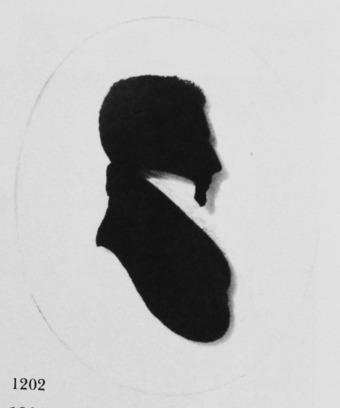
Edward Berkeley Portman, later Baron Portman
Silhouette painted on convex glass
1820
3 ¼ x 2 ½ in./83 x 64mm.
Trade label
Frame: papier mâché
Lord Portman was born on 9 July 1799. He graduated at Christ Church, Oxford, in 1820. On 16 June 1827 he married Emma, third daughter of Henry, the second Earl of Harewood.
M. A. H. Christie collection
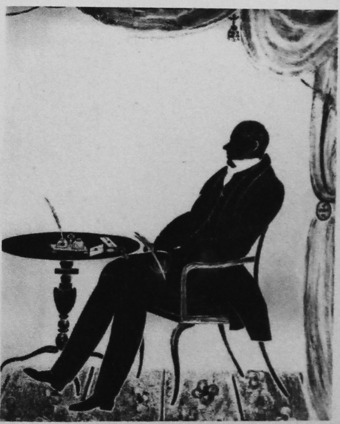
Unknown man
Silhouette painted on glass
c. 1824
10 ½ x 8 ½ in./267 x 216mm.
Frame: oak, with gilt surround
Attributed to Taylor on stylistic grounds.
Author’s collection
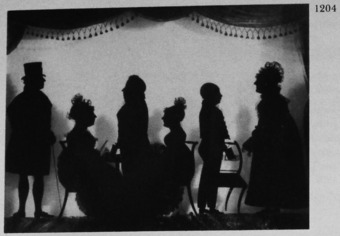
Unknown family
Group silhouette painted on glass
c. 1824-26
9 ½ x 12 ½ in./242 x 318mm.
Frame: gilt and gesso
Attributed to Taylor on stylistic grounds.
Author’s collection
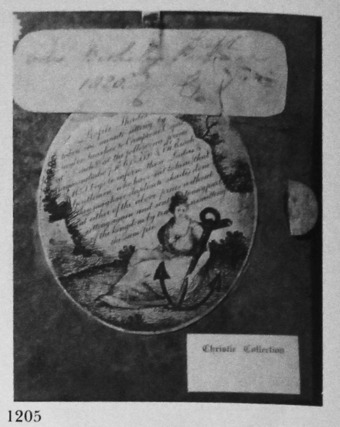
Trade Label of Isaac Taylor III, from the silhouette illustrated in 1202.
M. A. H. Christie collection
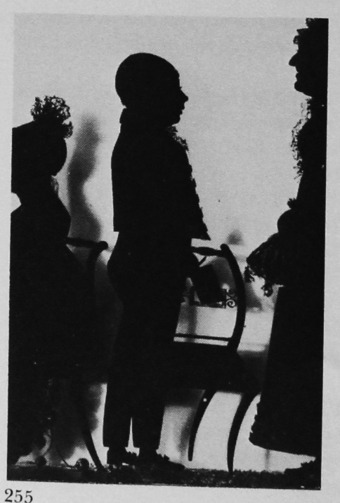
Unknown boy (aged eleven to twelve). Detail from a group portrait probably by I. Taylor, c. 1826.
costume dating points
The hair, fairly short and combed forwards, much in the style of the previous decade.
The collar of the jacket of the Eton suit, much like whose of men’s coats of the 1820s and half rolled down at the back.
The shirt, with a frill in front, like a man’s.
The trousers, rather narrow and short, worn with slightly square-toed shoes.
Author’s collection
SECTION THREE
